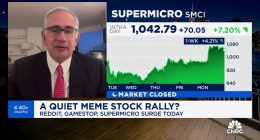
Chipotle and Walmart have been among the movers in the universe of big U.S. corporations when it comes to raising pay and offering debt-free college tuition assistance to large, low-wage workforces. Now, they’re sharing another tactic the companies say will have a long-term payoff for employees: publicly traded stock splits.
In a rapidly rising stock market, splitting shares is not a surprise. Before its split, Walmart shares were near an all-time high around $170. Chipotle, even further out on the market chart, has shares nearing $3,000 — its stock split is to be effective June 26.
Walmart’s 3-for-1-stock split, completed on Feb. 26, was its first in over 20 years. In its formal announcement, the company said that in addition to an “ongoing review of optimal trading and spread levels” the company made the move based on a “desire for its associates to feel that purchasing shares is easily within reach.”
For Chipotle, it’s the first stock split in the company’s 30-year history, and its announcement echoed Walmart’s. Both are hoping, through the availability of an employee stock purchase plan and financial education, they’ll get more workers to invest.
But it may not be so simple, according to benefits consultants.
Certainly, having a lower share price broadens ownership opportunities for employees to buy company stock, but it remains to be seen whether more rank-and-file workers will take advantage of company stock ownership opportunities.
“The idea that all of these employees are going to rush out to the market and start buying equity frankly doesn’t hold a lot of water,” said Michael Kestenbaum, managing director of Gallagher’s executive compensation practice.
Though a stock split can make shares more affordable, there are other factors at play, including how heavily a company promotes its ESPP, availability and employee usage of employer-sponsored financial education, and competing financial interests among lower-level employees, many of whom may be struggling to make ends meet.
Both companies say the split is being combined with other efforts to encourage employee stock ownership, including access to discounted stock through an ESPP and financial education offerings.
ESPP versus fractional shares
Even without a stock split, employees could have already purchased shares of their company, or at least fractional shares, through a brokerage account. But in some ways, ESPPs are preferable since the money comes directly out of an employee’s paycheck and there’s often a sizable employee discount. Walmart’s associate stock purchase plan, for example, allows eligible associates to buy stock through payroll deductions and provides a 15% company match on the first $1,800 each year.
Chipotle, meanwhile, offers a quarterly opportunity to buy its common stock at a price of 92.5% of the lower of the fair market value on the first and last trading days of each offering period, according to a regulatory filing.
What’s more, owning fractional shares has downsides. For example, whole shares are generally easy to transfer if you switch brokerages, whereas fractional shares may have to be sold in order to transfer the cash value.
Company stock and financial education
Splitting a stock and having a generous ESPP can only go so far when it comes to encouraging employees to buy the company stock. Companies that are serious about encouraging employee stock ownership also need to throw their weight behind financial education, according to benefits consultants and educators.
Companies that make the ESPP part of their culture, like many of the West Coast tech companies, see participation rates well over 50%, so it is possible, Dan Kapinos, partner and global practice leader of corporate governance and equity services at Aon, wrote in an email.
Prior to its IPO, Google provided significant education to employees related to stock options and financial literacy, said Clemens Kownatzki, assistant professor of finance at Pepperdine Graziadio Business School. “Without education, it’s pointless,” he said.
But most companies aren’t Google, the market has long since passed the Silicon Valley of two decades ago, and employee stock programs today are still not widely embraced at most companies. Typically, about 20% to 30% of an organization participates. Reasons for low participation can include lack of education about the plan and competing financial interests that employees are managing.
Most companies don’t offer robust financial education to workers. MetLife’s most recent annual employee benefits trends study, which was fielded in November, found that only 54% of employers offer financial planning and education workshops or tools.
Everyday demands on money
Companies will create more buy-in among employees if they have the education around what company stock programs mean for them and the ability to do things like balance their budget, said Aalap Shah, managing director at compensation consultancy Pearl Meyer. “How can I buy equities if I don’t know if I can afford it?” he said.
A Walmart spokesperson pointed to its partnership with Khan Academy to offer free online financial literacy courses to associates and their family members on topics such as budgeting and savings, financial goals, insurance, investments and retirement. The company also offers financial counseling through a partnership with Lyra Health Partners including tax planning, financial planning for debt, budgeting, retirement and more, according to its 2024 employee benefits book.
Chipotle is also trying to boost the financial education it offers to employees. It has a new partnership with SoFi that gives Chipotle employees access to the SoFi at Work Dashboard, a financial well-being education platform. This includes an assessment of current financial outlook, as well as suggestions and tools, according to a spokesperson.
No replacement for low-cost index funds
Even stellar education can fall short when it comes to prodding workers to buy company shares, Kownatzki said. For employees struggling to make ends meet, the first priority is to put food on the table, pay rent and meet other basic needs. “When you’re only making $15 to $20 an hour, just getting food on the table is clearly more important than buying stock. No question about that,” he said.
For employees who have some discretionary income, investing in their company’s stock could be a good tool as part of an overall investment strategy. But even so, Kownatzki said many people would be better off buying a small fraction of shares in a low-cost index fund and accumulating that over time. “I would rather have diversification in an index fund,” he said.
Saving for retirement is also a goal that — if they are doing it — leaves many workers with little to no extra cash to spare. That’s an issue BlackRock’s Chairman Larry Fink focused on in his annual letter to investors, released earlier this week. “As a society, we focus a tremendous amount of energy on helping people live longer lives. But not even a fraction of that effort is spent helping people afford those extra years,” he wrote in the letter.
Upping the financial incentives
If getting equity into the hands of employees is really important to employers, companies have several options.
Many companies already offer an ESPP, but they could choose to enhance what they are offering, Kestenbaum said. For instance, if they don’t offer a discount, they could. Or, maybe they could create a longer lookback period to allow employees to take advantage of an even lower stock price, or offer a larger discount on an ESPP plan, he said.
Another option would be to give equity awards to lower-level workers as part of their compensation. Emerging companies, technology players and fintechs have historically been focused on broader equity participation, he said.
But other companies could also consider the strategy. Bank of America, for example, has decided to give restricted stock bonuses worth a collective $800 million to roughly 97% of its staff. Employees who earn less than $500,000 in total annual pay are eligible for the award. Walmart is offering an annual stock grant of up to $20,000 to managers.
Of course, an equity grant strategy could be expensive for companies — especially those with a large employee base — so that needs to be taken into consideration, Kestenbaum said.
Read More: World News | Entertainment News | Celeb News
CNBC










